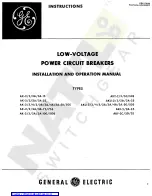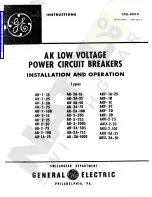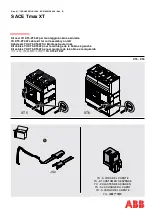
Electrically Operated Circuit Breakers
The mechanism of the electrically operated circuit breaker is the
same as the manually operated circuit breaker, except that the
manual-charging handle is replaced by a motor and gear system.
Refer to
Figure
2
and Table
2.
Power available to the control
circuit will start the automatic charging cycle. The motor gear-box
pinion rotates gear (81) counterclockwise. Cam follower (82)
engages an arm of wind and close cam (34), which rotates the
cams in the same manner as for the manually charged circuit
breaker. When the wind and close cam (34) reaches its charged
position, the back of the cam engages switch lever (73), rotating the
lever away from the switch operator. Gear switch lever (76) will still
be holding the switch in the operate position and the motor will
continue to run until the roll pins on the side of gear (81) lift lever
(76) clear. This releases the motor cutoff switch (MCO). When the
MCO switch opens, the motor stops, and the closing coil circuit is
set up through one side of the MCO switch.
The circuit breaker can now be closed by depressing the latch hood
(50) or by energizing the closing coil (CC) through the external
close control switch (CS/C). When the close circuit is energized, the
anti-pump (Y) relay is energized and opens the Y
relay contact in the closing circuit. This prevents "pumping" or
repeated attempts to close the circuit breaker if a tripping signal or
fault is present. This would happen if the closing switch (CS/C) is
bypassed by a short circuit, or if it is defective.
A combination manually and electrically operated circuit breaker is
also available. This includes both the motor-gear charging system as
well as the manual charge handle.
Note:
Manual charging handle must be in vertical po
s i
tion
during electrical charging. Failure to follow this instruction
will
cause the mechanism to jam, damaging the motor and the
mechanism.
Table
2.
Operating Procedure for Electrically Operated Circuit
Breakers
Procedure
Charging Springs
Energize control circuit
Closing
After the springs are charged, Actuate the
external close control switch (CS/C).
OR
Push down firmly on spring-release latch-
hood
(50)
(Afte
r
spring
charging handle (if pr
e
se
n
t
)
i
s
returned to normal vertical position.)
Tripping
Actuate external Control Switch (CSIT)
to Trip or Open Breaker.
OR, Push in manual trip rod
(94).
Drawout Interlock
9
A draw-out circuit breaker mechanism includes:
1.
Means to rack the circuit breaker in or out of the compartment.
2.
Interlock to prevent racking a closed circuit breaker into or out
of any position.
3.
Interlock to prevent closing a circuit breaker while it is racked
to any position between the TEST and CONNECT position.
4.
Interlock to prevent withdrawing a circuit breaker from the
cubicle while the closing springs are charged.
Rack
ing Mechanism
Refer to
Figure
4.
With the circuit breaker resting on the cubicle
rails, the following sequence should be used to rack the circuit
breaker into the cubicle.
1.
Push trip bar in, open racking window and insert racking
crank.
N ote: Racking window cannot be opened unless manual trip bar is
pressed in. While the trip bar is pressed in, the circuit breaker is
TRIP FREE and cannot be closed.
2.
Using the racking crank, rotate the racking screw (105)
counterclockwise until the racking shaft is in the DISCONNECTED
position. The racking clevis can now engage the racking pins in the
cubicle.
The circuit breaker should now be pushed along the rail
into the DISCONNECTED position. Double check that the racking
clevises engage the pins on both sides of the cubicle.
3
Clockwise rotation of the racking screw will rack the breaker
into the TEST position. At the TEST position, the racking window
can be closed, allowing the trip bar to reset and the circuit breaker
can be operated. Further racking will place the circuit breaker
between
the TEST and CONNECTED positions. Between
positions, the interlock bar will not engage the position holes of the
cuoicle.
The breaker will be held TRIP FREE and cannot be closed.
4.
In the CONNECTED position, the interlock bar will engage the
cubicle hole, releasing the trip bar to reset and
a
l
l
ow
i
ng
circuit
breaker
to be closed. This prevents closing a circuit breaker that
is
not in the CON NECTED or TEST position.
5.
To withdraw the breaker from the CONNECTED position, the
procedure is the same only the racking screw is rotated in the
counterclockwise direction. When racking the breaker out to the
DISCON NECTED position, the closing s prings
w
il
l automatically
discharge, at or before reaching the DISCONNECTED position.
IMPORTANT:
To avoid damage to the racking
mechanism, when in the CONNECTED position, do not
fo
r
cefully rotate the racking crank clockwise.
www
. ElectricalPartManuals
. com
Содержание RL Series
Страница 2: ... w w w E l e c t r i c a l P a r t M a n u a l s c o m ...
Страница 4: ...w w w E l e c t r i c a l P a r t M a n u a l s c o m ...
Страница 6: ...w w w E l e c t r i c a l P a r t M a n u a l s c o m ...
Страница 8: ...w w w E l e c t r i c a l P a r t M a n u a l s c o m ...
Страница 10: ...w w w E l e c t r i c a l P a r t M a n u a l s c o m ...
Страница 12: ...w w w E l e c t r i c a l P a r t M a n u a l s c o m ...
Страница 14: ...w w w E l e c t r i c a l P a r t M a n u a l s c o m ...
Страница 16: ...w w w E l e c t r i c a l P a r t M a n u a l s c o m ...
Страница 18: ...w w w E l e c t r i c a l P a r t M a n u a l s c o m ...
Страница 20: ...w w w E l e c t r i c a l P a r t M a n u a l s c o m ...
Страница 22: ...w w w E l e c t r i c a l P a r t M a n u a l s c o m ...
Страница 24: ...w w w E l e c t r i c a l P a r t M a n u a l s c o m ...
Страница 26: ...w w w E l e c t r i c a l P a r t M a n u a l s c o m ...
Страница 28: ...w w w E l e c t r i c a l P a r t M a n u a l s c o m ...
Страница 30: ...w w w E l e c t r i c a l P a r t M a n u a l s c o m ...
Страница 32: ...w w w E l e c t r i c a l P a r t M a n u a l s c o m ...
Страница 34: ...w w w E l e c t r i c a l P a r t M a n u a l s c o m ...
Страница 36: ...w w w E l e c t r i c a l P a r t M a n u a l s c o m ...
Страница 38: ...w w w E l e c t r i c a l P a r t M a n u a l s c o m ...
Страница 40: ...w w w E l e c t r i c a l P a r t M a n u a l s c o m ...
Страница 42: ...w w w E l e c t r i c a l P a r t M a n u a l s c o m ...
Страница 44: ...w w w E l e c t r i c a l P a r t M a n u a l s c o m ...
Страница 46: ...w w w E l e c t r i c a l P a r t M a n u a l s c o m ...
Страница 48: ...w w w E l e c t r i c a l P a r t M a n u a l s c o m ...
Страница 50: ...w w w E l e c t r i c a l P a r t M a n u a l s c o m ...
Страница 52: ...w w w E l e c t r i c a l P a r t M a n u a l s c o m ...
Страница 54: ...w w w E l e c t r i c a l P a r t M a n u a l s c o m ...
Страница 56: ...w w w E l e c t r i c a l P a r t M a n u a l s c o m ...
Страница 58: ...w w w E l e c t r i c a l P a r t M a n u a l s c o m ...
Страница 60: ...w w w E l e c t r i c a l P a r t M a n u a l s c o m ...
Страница 62: ...w w w E l e c t r i c a l P a r t M a n u a l s c o m ...
Страница 64: ...w w w E l e c t r i c a l P a r t M a n u a l s c o m ...
Страница 66: ...w w w E l e c t r i c a l P a r t M a n u a l s c o m ...
Страница 68: ...w w w E l e c t r i c a l P a r t M a n u a l s c o m ...
Страница 70: ...w w w E l e c t r i c a l P a r t M a n u a l s c o m ...
Страница 72: ...w w w E l e c t r i c a l P a r t M a n u a l s c o m ...
Страница 74: ...w w w E l e c t r i c a l P a r t M a n u a l s c o m ...
Страница 76: ...w w w E l e c t r i c a l P a r t M a n u a l s c o m ...
















































